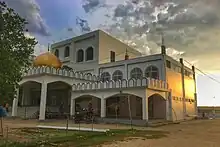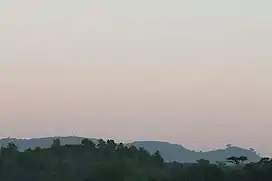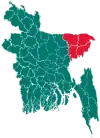Kulaura
কুলাউড়া | |
|---|---|
.svg.png.webp) | |
| Coordinates: 24°31′N 92°2′E / 24.517°N 92.033°E | |
| Country | |
| Division | Sylhet |
| District | Moulvibazar |
| Government | |
| • MP (Moulvibazar-2) | Shafiul Alam Chowdhury Nadel (Awami League) |
| • Upazila Chairman | AKM Shafi Ahmed Solman (Awami League) |
| Area | |
| • Total | 545.73 km2 (210.71 sq mi) |
| Population | |
| • Total | 360,195 |
| • Density | 660/km2 (1,700/sq mi) |
| Demonym | Kulauri |
| Time zone | UTC+6 (BST) |
| Postal code | 3230 |
| Area code | +8624 |
| Website | kulaura |
Kulaura (Bengali: কুলাউড়া) is the biggest upazila (subdistrict) of the Moulvibazar District in north-eastern Bangladesh.[1] The total area of this upazila is 545 km2. Hakaluki Haor, the largest marsh wetland in Sylhet Division and one of the largest in Bangladesh is partially located there.
Climate
Kulaura has a humid subtropical climate. The Köppen-Geiger climate classification is Cwa. The climate of Kulaura is generally marked with monsoons, high temperature, considerable humidity and heavy rainfall. The hot season commences early in April and continues till July. The average annual temperature in Kulaura is 24.7 °C (76.5 °F). About 2,805 mm (110.43 in) of precipitation falls annually.
| Climate data for Kulaura | |||||||||||||
|---|---|---|---|---|---|---|---|---|---|---|---|---|---|
| Month | Jan | Feb | Mar | Apr | May | Jun | Jul | Aug | Sep | Oct | Nov | Dec | Year |
| Mean daily maximum °C (°F) | 25.6 (78.1) |
27.7 (81.9) |
31.6 (88.9) |
32.7 (90.9) |
31.5 (88.7) |
31.6 (88.9) |
31.6 (88.9) |
31.6 (88.9) |
31.8 (89.2) |
30.8 (87.4) |
29.1 (84.4) |
26.5 (79.7) |
30.2 (86.3) |
| Mean daily minimum °C (°F) | 9.7 (49.5) |
12.2 (54.0) |
17.1 (62.8) |
21.1 (70.0) |
23.0 (73.4) |
24.4 (75.9) |
25.0 (77.0) |
24.9 (76.8) |
24.6 (76.3) |
21.9 (71.4) |
16.3 (61.3) |
11.5 (52.7) |
19.3 (66.8) |
| Average precipitation mm (inches) | 13 (0.5) |
29 (1.1) |
103 (4.1) |
249 (9.8) |
422 (16.6) |
570 (22.4) |
460 (18.1) |
402 (15.8) |
313 (12.3) |
204 (8.0) |
34 (1.3) |
6 (0.2) |
2,805 (110.4) |
| Source: Climate-Data.org,Climate data | |||||||||||||
History

Many archaeological sites and relics such as the Vidia Ashram in Rangirkul, Gagan Tila, Chand Gram Dighi and the copper plates of Bhatera provide evidence for early settlements in Kulaura.[2]
The East India Company first heavily influenced their trading of tea in Kulaura.[3][4] It became an important location for tea cultivation in Bengal and major export. Local entrepreneurs also started founding their estates such as Nawab Ali Amjad Khan who established the Rungicherra (also Rungichara) Tea Estate.
In the anti-British Sepoy Mutiny of 1857, 300 sepoys who revolted against the British, looted the Chittagong Treasury and took shelter with Nawab Gous Ali Khan of Prithimpassa. The treasury remained under rebel control for several days.[5] Abdul Ghafur, grandfather of Ali Haydar ibn Ali Gawhar, of Kanihati was present during the mutiny.[6]
In 1921, the non-cooperation movement also spread to Kulaura after being established by Purnendu Kishore Sengupta in Vidia Ashram, Rangirkul. In 1939, there was an anti-British protest held in Nabin Chandra School. Many students were attacked and expelled by the British forces based in Kalapani Haor.[2]
In 1950, the Shah of Iran, Mohammad Reza Pahlavi, visited Prithimpassa and stayed for four days at the palace and went wildlife hunting in the Estate forests alongside Khwaja Nazimuddin and Ayub Khan.
During the Bangladesh Liberation War, Kulaura was the centre of the Battle of Gazipur in Gazipur Tea Garden. The battle raged from the 4th to the 5th of December 1971 and was a prelude to the Battle of Sylhet. The Pakistani army camped in Kulaura Hospital and Nabin Chandra School and killed over 100 Bengali freedom fighters and civilians. Chiral Muchir Bari, bank of Padma Dighi of Ali Amjad High School were experienced mass killings. A graveyard in Chatolgaon hosts many martyrs.[2]
Geography

The location of Kulaura upazila is 24.5167 degrees north latitudes up to 92.0333 degrees East longitude. The Area size 679.25 square kilometers (262 square miles). Barolekha, Juri and Fenchuganj Upazilas on the north, Rajnagar and Kamalganj upazila on the west, Tripura of India on the south, Tripura and Assam in the east of Kulaura.
The largest Haor of in Asia, 'Hakaluki's most of area is under Kulaura. Also Longlia, Gualzoor etc. are the notable Haor. The highest peak in the Sylhet region, Kala pahar, can be found in Kulaura Upazila.
Economy and tourism
Kulaura is home to many tourist attractions and natural geography. It contains many hills, tea gardens and the largest haor in Asia; the Hakaluki Haor. Kadipur Shib Bari Temple is the largest Hindu temple in Sylhet situated at Kulaura. Hindu goddess Durga's sculpture of 1000 hands is inside the temple. There is also a ISKCON temple in Rangirkul, Kulaura known as "Rangirkul Bidyashram" & a CTS temple at Pushainagar. Other sites include the Prithimpassa Nawab Estate, Rabir Bazar Jame Masjid, and the mausoleums of Haji Pir in Sharifpur, Shah Hamid Faruqi in Kaukapon and Shah Helimuddin Qurayshi Chowdhury Bazar.
Demographics
According to the 2011 Bangladesh census, Kulaura Upazila had 66,465 households and a population of 360,195. 93,400 (25.93%) were under 10 years of age. Kulaura had a literacy rate (age 7 and over) of 51.88%, compared to the national average of 51.8%, and a sex ratio of 1049 females per 1000 males. 27,491 (7.63%) lived in urban areas.[7] Ethnic population was 11,804 (3.28%), of which Khasi were 4,311.[8]
At the 1991 Bangladesh census, Kulaura had a population of 339,673, of whom 171,346 were aged 18 or older. Males constituted 51.09% of the population and females 48.91%. Kulaura had an average literacy rate of 28.8% (7+ years) compared to the national average of 32.4%.[9]
Administration
Kulaura Upazila is divided into Kulaura Municipality and 13 union parishads: Baramchal, Bhatera, Bhukshimail, Brammanbazar, Hazipur, Joychandi, Kadipur, Kormodha, Kulaura, Prithimpassa, Rauthgaon, Sharifpur, and Tilagaon union. The union parishads are subdivided into 128 mauzas and 447 villages.[7]
Kulaura Municipality is subdivided into 9 wards and 26 mahallas.[7]
Notable people
- Abdul Jabbar, politician and former member of parliament
- Nadia Shah, politician, councillor and former Mayor of Camden. In May 2016, she became the first female British Bangladeshi mayor.[10]
- Kanihati zamindars
- Abdul Muntaquim Chaudhury, former Member of the Pakistan National Assembly
- Sadeq Ali, writer, poet and judge best known for the Halat-un-Nabi puthi
- Sultan Mohammad Mansur Ahmed, politician, Former VP of DUCSU, Former President of Bangladesh Chhatra League, Former Organising Secretary of Bangladesh Awami League and the Current Member of the Jatiya Sangsad from Moulvibazar-2.
- Rawshan Ara Bachchu, Bengali Language Movement activist
- Zamindars of Monraj
- A. N. M. Yusuf - Bangladesh Muslim League politician
- Abul Hasan - cricketer
- MM Shahin - politician
- Shafiqur Rahman - physician and Amir of the Bangladesh Jamaat-e-Islami
- Abdul Matin - former MP for Moulvibazar-2
- Prithimpassa Family
- Ali Amjad Khan - 8th Nawab of Longla and Honorary Magistrate
- Ali Abbas Khan - Jatiya Party politician
- Ali Haider Khan - 9th Nawab of Longla and politician
See also
References
- ↑ Samir Uddin Ahmed (2012). "Kulaura Upazila". In Sirajul Islam; Miah, Sajahan; Khanam, Mahfuza; Ahmed, Sabbir (eds.). Banglapedia: the National Encyclopedia of Bangladesh (Online ed.). Dhaka, Bangladesh: Banglapedia Trust, Asiatic Society of Bangladesh. ISBN 984-32-0576-6. OCLC 52727562. OL 30677644M. Retrieved 14 January 2024.
- 1 2 3 Samir Uddin Ahmed (January 2003). "Kulaura Upazila". In Sirajul Islam (ed.). Banglapedia. Dhaka: Asiatic Society of Bangladesh. ISBN 984-32-0576-6. Retrieved May 12, 2016.
- ↑ Colleen Taylor Sen (2004). Food Culture in India. Greenwood Publishing Group. p. 26. ISBN 978-0-313-32487-1.
- ↑ "Tea Industry". Banglapedia: National Encyclopedia of Bangladesh. Asiatic Society of Bangladesh.
- ↑ "Rare 1857 reports on Bengal uprisings". Times of India.
- ↑ Sreehatter Itibritta – Uttorangsho (A History of Sylhet), page 263-264, Achyut Charan Choudhury; Publisher: Mustafa Selim; Source publication, 2004
- 1 2 3 4 "Bangladesh Population and Housing Census 2011 Zila Report – Maulvibazar" (PDF). bbs.gov.bd. Bangladesh Bureau of Statistics.
- ↑ "Community Tables: Maulvibazar district" (PDF). bbs.gov.bd. Bangladesh Bureau of Statistics. 2011.
- ↑ "Population Census Wing, BBS". Archived from the original on 2005-03-27. Retrieved November 10, 2006.
- ↑ "Britain's first woman mayor of Bangladeshi origin". Dhaka Tribune. Dhaka. 12 May 2017. Retrieved 1 June 2017.
